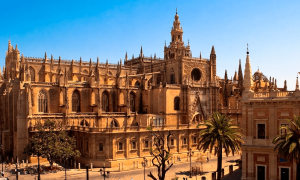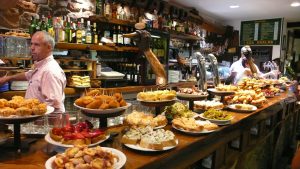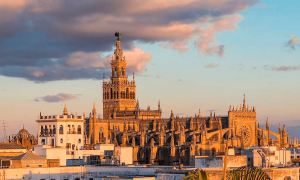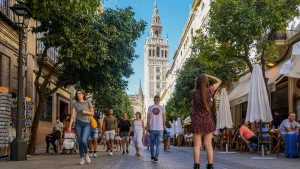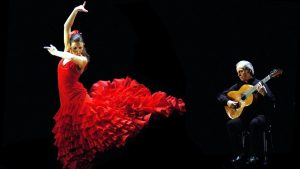
Easter in Seville: A unique Baroque Experience
Easter in Seville welcome the travelers with a festival of colors and perfumes in the streets of Seville. It catched the senses in a unique Baroque fashion. We’ll try to explain why and how.
Baroque isn’t just an art style born in Italy that produced paintings and sculptures so expressive they look alive. Baroque is also a way of life and feeling that can be still experienced in southern Spain, especially in Seville during Easter, the Holy Week: Semana Santa. The city hosts the most spectacular, lively and colorful week of processions of the world, where the past of Seville comes back with its XVI and XVII Centuries of Gold.
From Palm Sunday to Resurrection, the old city is crossed by seven or more processions a day, some last five hours and some last fifteen! Each procession consists of two long lines of penitents carrying tall candles and hiding their faces with pointed hoods, then the hornet’s band and a big mobile float with images of the Virgin Mary or a sculptural group involving Jesus Christ in one of the phases of his calvary. Those floats weigh thousands of kilos and are carried by the sack men called costaleros, because each one of them carries 40 kg on his neck using a sack, el costal, for protection. Each brotherhood or guild may take to the streets two or three pasos, the incredibly richly decorated floats full of silver, gold embroidery on velvet and flowers. The most ancient brotherhood is la Hermandad de los Negritos, founded in the 14th century by the black slaves of Seville.
How do these pasos move? Slowly, sometimes swinging and making Virgin Mary’s float graciously dance during the procession. When the costaleros do it especially well, thousands of peoples start to cry for joy. Suddenly, a shocking flamenco voice breaks the babbling of the people in the street and the procession stops. Somebody has decided to sing a saeta dedicated to Jesus or the Virgin and for a few minutes he or she pierces the heart of thousands, far beyond their beliefs.
Floods of people move in waves from one street to another, chasing their favorite pasos, band and image. Bars and taverns are packed with people relishing traditional Easter pastries like torrijas (toasted slices of bread soaking in sugared milk, and flavoured with cinnamon, then bathed in egg and fried) or cod or lamb-based dishes.
In the morning, visitors are allowed to enter the chapels and admire the images and artwork before they take to the streets. If the sky gets cloudy, noses point to the sky hoping not to savor the rain.
Semana Santa, Sevillan style, may also be enjoyed in Ronda, Jerez, Sanlúcar, Utrera and many towns around; they all offer both their own little peculiarities and common features, such as people from the balconies throwing rose petals over the image of Virgin Mary, enormous floats entering narrow streets with only a few inches left at the sides for moving along the streets.
The scents of Semana Santa are orange blossom that we call azahar, from the 40 thousand orange trees planted inside Seville, then incense, jasmine, torrijas and, of course, candle wax. All together, it is a baroque experience that lives through your senses, rather than your rationality.

Easter in Seville: A unique Baroque Experience
Easter in Seville welcome the travelers with a festival of colors and perfumes in the streets of Seville. It catched the senses in a unique Baroque fashion. We’ll try to explain why and how.
Baroque isn’t just an art style born in Italy that produced paintings and sculptures so expressive they look alive. Baroque is also a way of life and feeling that can be still experienced in southern Spain, especially in Seville during Easter, the Holy Week: Semana Santa. The city hosts the most spectacular, lively and colorful week of processions of the world, where the past of Seville comes back with its XVI and XVII Centuries of Gold.
From Palm Sunday to Resurrection, the old city is crossed by seven or more processions a day, some last five hours and some last fifteen! Each procession consists of two long lines of penitents carrying tall candles and hiding their faces with pointed hoods, then the hornet’s band and a big mobile float with images of the Virgin Mary or a sculptural group involving Jesus Christ in one of the phases of his calvary. Those floats weigh thousands of kilos and are carried by the sack men called costaleros, because each one of them carries 40 kg on his neck using a sack, el costal, for protection. Each brotherhood or guild may take to the streets two or three pasos, the incredibly richly decorated floats full of silver, gold embroidery on velvet and flowers. The most ancient brotherhood is la Hermandad de los Negritos, founded in the 14th century by the black slaves of Seville.
How do these pasos move? Slowly, sometimes swinging and making Virgin Mary’s float graciously dance during the procession. When the costaleros do it especially well, thousands of peoples start to cry for joy. Suddenly, a shocking flamenco voice breaks the babbling of the people in the street and the procession stops. Somebody has decided to sing a saeta dedicated to Jesus or the Virgin and for a few minutes he or she pierces the heart of thousands, far beyond their beliefs.
Floods of people move in waves from one street to another, chasing their favorite pasos, band and image. Bars and taverns are packed with people relishing traditional Easter pastries like torrijas (toasted slices of bread soaking in sugared milk, and flavoured with cinnamon, then bathed in egg and fried) or cod or lamb-based dishes.
In the morning, visitors are allowed to enter the chapels and admire the images and artwork before they take to the streets. If the sky gets cloudy, noses point to the sky hoping not to savor the rain.
Semana Santa, Sevillan style, may also be enjoyed in Ronda, Jerez, Sanlúcar, Utrera and many towns around; they all offer both their own little peculiarities and common features, such as people from the balconies throwing rose petals over the image of Virgin Mary, enormous floats entering narrow streets with only a few inches left at the sides for moving along the streets.
The scents of Semana Santa are orange blossom that we call azahar, from the 40 thousand orange trees planted inside Seville, then incense, jasmine, torrijas and, of course, candle wax. All together, it is a baroque experience that lives through your senses, rather than your rationality.

